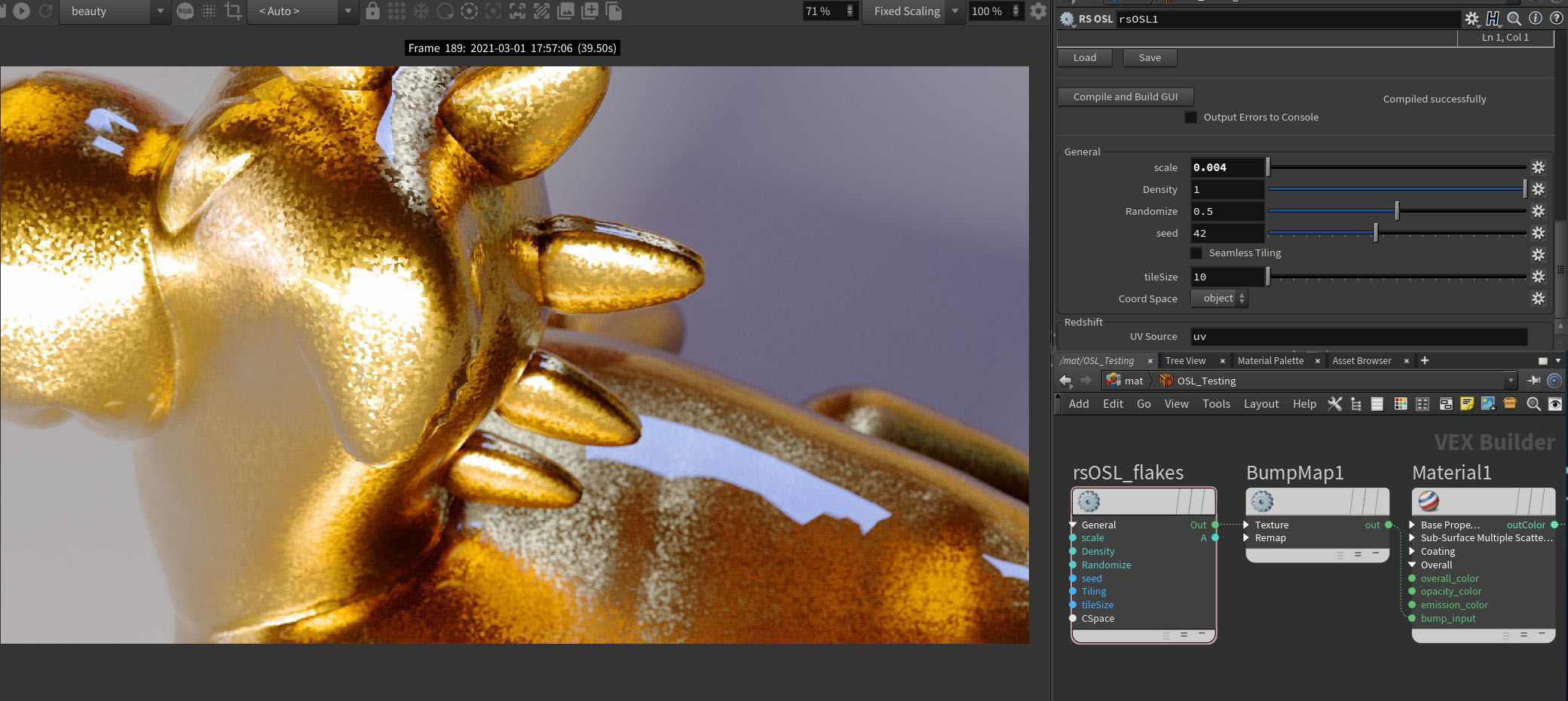
// Make glint reflections, ice, snow, and car shaders for example.// Flakes.osl, by Mads Drøschler// Modified: 2021-02-31// License MIT Copyright Mads Drøschler// https://github.com/gkmotu/OSL-Shaders// Modified: 2021-03-01 by Saul Espinosa for Redshift 3D. Added Metadata + Mapper Menu for Coordinate Spacevector TileHash ( output vector x, int tileSize ) { x = mod(x,tileSize); return noise("hash",x);}vector ID(vector x, int seed,int Tiling,int tileSize){ vector n = floor(x); vector f = x-floor(x); vector m = vector(8); vector o; for( int k=-1; k<=1; k++ ){ for( int j=-1; j<=1; j++ ){ for( int i=-1; i<=1; i++ ){ vector g = vector( float(i), float(j),float(k) ); Tiling? o = TileHash(n+g,tileSize) : o = noise("hash",n+g,seed); vector r = g - f + (0.5+0.5*sin(M_2PI*o)); float s = dot(r, r); s<m[0] ? m = vector(s, o[0], o[1]):0; }}} return vector( sqrt(m[0]), m[1]+m[2], m[1]+m[0]);}float IDs ( output float x, int seed ){ x = -1000 + x * 2000; x = int(trunc(x)); float x_ratio = noise("cell", vector(abs(x), abs(seed), 11)); return mix(0, 1, x_ratio);} shader Flakes [[ string help = "Use the Flakes shader to create small glints in surfaces", string label = "Flakes" ]] ( // Inputs float scale = 0.2 [[ int connectable = 0, float min = 0.0, float max = 25.0, string help = "<ul><br><li>Scale the IDs up and down. ( This is disabled when Seamless Tiling is enabled )<br></li>" "<li>Use the Tile Size instead when Seamless Tiling is enabled.</li></ul>" ]], float Density = 1.0 [[ int connectable = 0, float min = 0.0, float max = 1.0, string help = "<ul><br><li>0.0 will print 0% IDs<br></li>" "<li>0.5 will print 50% of the IDs<br></li>" "<li>1.0 will cover the whole surface with ID's</li></ul>" ]], float Randomize = 0.5 [[ int connectable = 0, float min = 0.0, float max = 1.0, string help = "<ul><br><br>A value between 0-1 that will rotate the IDs<br>" "<li>If value is 0, the IDs will point straight up from the surface ( no glints )<br></li>" "<li>If value is 0.5, the IDs will be rotated randomly around 180 deg. ( mild dispersion )<br></li>" "<li>If value is 1, the IDs will be rotated randomly around 360 deg.( Very scattered dispersion )</li></ul>" ]], int seed = 42 [[ int connectable = 0, int min = 0, int max = 100, string help = "<br><br>Reshuffle the layout of the IDs" ]], int Tiling = 0 [[ string widget = "checkBox", string label = "Seamless Tiling", int connectable = 0, string help = "<ul><br><br><li>Plug the Flake Shader directly into the Physical Materials diffuse slot</li>" "<br><li>Make a square plane, 100x100/250x250/etc.</li>" "<br><li>Assign the material to the plane.</li>" "<br><li>Enable Seamless Tiling.</li>" "<br><li>Adjust the size of the texure details with the Tile Size parameter.</li>" "<br><li>Bake an Arnold Albedo texture to .exr and convert it to .tx with mipmapping enabled, for optimal performance.</li><br>" "<br>You now have a Seamless Tiling OSL Flake bitmap.</ul>" ]], int tileSize = 10 [[ int min = 10, int max = 50, int connectable = 0, string help = "<br><br>Increase value to sample more IDs on the seamless tile" ]], int CSpace = 0 [[ string label = "Coord Space", string widget = "mapper", string options = "object:0|world:1|UV:3", string help = "<ul><br><li>Object</li><br>" "<li>World</li><br>" "<li>UV (Texture)</li></ul>" ]], // Output output normal Out = 0.0, output float A = 0,){ // Coord Space string mode; point pos,s = P; vector t = vector(u,v,0); CSpace == 0 ? mode = "object" : mode = "world"; CSpace == 2 ? pos = transform("object",t) : pos = transform(mode,s); Tiling ? pos = transform("object",t):0; // Scale !Tiling ? pos = pos : pos = pos*tileSize; float sc = scale; !Tiling ? sc = sc : sc = 1.0; // Point point p = (pos)/sc; // Base Normal vector Base_Normal = vector(0.5,0.5,1.0); // Fetch global ID vector k = ID( p,seed,Tiling,tileSize ); // Turn float x = 0.5 + 0.5 * cos( k[1]*M_2PI ); float y = 0.5 + 0.5 * sin( k[1]*M_2PI ); float z = 0.5 + 0.5 * tan( k[1]*M_2PI ); // Normalize Out = normalize(vector(x,y,z)*2-1)*0.5+0.5; // Fetch xyz IDs Out[0] = IDs(Out[0],4); Out[1] = IDs(Out[1],4); Out[2] = IDs(Out[2],1); // Fit z to 0.5 - 1.0 Out[2] = 0.5 + 0.5 *Out[2]; // Density float h = -1000 + Out[0]*2000; h = int(trunc(h)); float Rehash = noise("cell", vector(abs(h), abs(16), 11)); Rehash = mix(0, 1, Rehash); Density > Rehash ? Out = Out : Out = Base_Normal; // A Out[0] > 0.5 or Out[0] < 0.5 ? A = 1 : A = 0; // Randomize Out = mix(Base_Normal,Out,Randomize); //Out = Out*2-1; }


